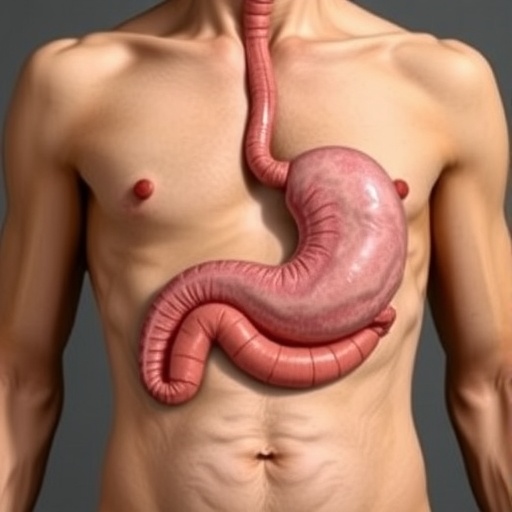In a groundbreaking advance poised to reshape our understanding of human gastric development, researchers have unveiled a novel in vitro model that faithfully replicates the early regional patterning of the human stomach. The study introduces “human gastroids,” multi-lineage gastric organoids derived from human pluripotent stem cells (hPSCs), which demonstrate self-organized fundic–antral patterning reminiscent of stomach organogenesis in vivo. This innovation overcomes longstanding challenges in modeling the complex anterior-posterior axis of the stomach, offering a powerful platform to dissect the cellular and molecular circuitry underlying stomach development and disease.
The human stomach is a highly specialized organ exhibiting distinct regional functionalities along its anterior-posterior axis. Key regions such as the fundus and antrum serve unique physiological roles, governed by discrete cellular identities and signaling milieus. Historically, deciphering the mechanisms governing this regionalization has relied heavily on animal models, primarily mouse, chicken, and other vertebrate embryos. While these models have provided foundational insights, their limitations have impeded the translation of findings to human biology due to species-specific differences in stomach patterning and development.
Recent developments in stem cell biology have enabled the generation of gastric organoids from hPSCs, recapitulating many aspects of fundic and antral epithelial differentiation. However, existing protocols have struggled to spontaneously orchestrate the emergence of clear, self-organized anterior-posterior patterning within a single organoid, restricting their utility in modeling the emergent spatial domains crucial for function. The new study breaks this barrier by co-culturing multiple germ layers—including endoderm, mesenchyme, and neural populations—to more faithfully simulate the native developmental environment.
Central to this advance is the ability of human gastroids to form a polarized epithelial chamber structured with a bipolar fundic–antral axis. This structure is enveloped by mesenchymal cells and punctuated near the fundic domain by neural populations, yielding a three-dimensional architecture strikingly akin to early human stomach anatomy. This multi-lineage integration not only generates cellular and molecular heterogeneity but also replicates intricate intercellular signaling networks vital for spatial patterning and differentiation.
Intriguingly, the study highlights a pivotal role for non-endodermal cells—in particular, neural populations—as key signaling centers orchestrating fundic–antral patterning through WNT-mediated crosstalk. This finding challenges the traditional focus on epithelial intrinsic factors, underscoring the importance of cross-germ-layer communication in early stomach development. Neural cells appear to coordinate localized WNT signaling gradients, which in turn instruct epithelial cells toward region-specific identities, a mechanism potentially conserved from embryonic stages.
The authors employed single-cell transcriptomic profiling to dissect the cellular landscape of these gastroids at unprecedented resolution. This approach revealed diverse cell populations spanning epithelial, mesenchymal, and neural lineages, each characterized by distinct gene expression signatures mapping to specific stomach regions. Importantly, genetic silencing studies identified NR2F2—a nuclear receptor transcription factor—as a critical mediator of the fundic–antral patterning process, acting downstream of neural WNT signals to regulate regional gene expression programs.
By recapitulating complex wall structures, regional marker expression, and neural-mesenchymal-epithelial interactions within a controlled in vitro setting, this model offers an unparalleled window into the early developmental events shaping the human stomach. It opens avenues for probing congenital gastric disorders, epithelial metaplasia, and cancer predisposition through human-relevant systems. Moreover, it establishes a scalable platform for drug screening and regenerative medicine applications targeting gastric diseases.
This pioneering work builds upon and advances prior studies that have mapped the role of WNT signaling, transcription factors such as Barx1 and COUP-TFII, and developmental cues in stomach patterning within animal models. However, the leap to human-specific, multi-germ-layer organoids marks a paradigm shift, enabling direct interrogation of human gastric biology unencumbered by species differences. The integration of neural components as active patterning elements in organoid design further expands the conceptual framework of organogenesis.
Furthermore, the demonstration of intrinsic self-organization in gastroids underscores a fundamental principle of developmental biology—emergence of regional identity through spatially coordinated cell-cell communication. The fusion of stem cell engineering with high-throughput genomics and genetic manipulation techniques exemplifies the frontier of tissue modeling, where complexity and fidelity converge. It heralds a new era wherein engineered organoids can recapitulate developmental patterning processes with remarkable precision.
The implications of this research ripple beyond basic developmental biology. Given the stomach’s central role in digestion, immunity, and microbiome interactions, the ability to model its regionalized development could transform studies into gastrointestinal diseases ranging from ulcers to gastric cancer. By providing a human-centric platform, gastroids may facilitate biomarker discovery, disentangling pathogenic mechanisms and identifying novel therapeutic targets grounded in developmental pathways.
The study also highlights the feasibility and power of incorporating neuro-mesenchymal-epithelial crosstalk into organoid systems—an approach that could be generalized to other organs where complex tissue interactions govern morphogenesis. Delineating the signaling hierarchies and transcriptional networks in these contexts may accelerate engineering of more sophisticated organoids with physiological and pathological relevance. Neural cells, once viewed solely as functional components, are now appreciated as integral developmental architects shaping tissue architecture.
In sum, this research represents a transformative step in modeling human gastric organogenesis, bridging gaps between developmental biology, stem cell technology, and disease modeling. By faithfully recapitulating fundic-antral patterning through multi-lineage co-development and identifying key signaling mediators like NR2F2, the study offers a robust, high-fidelity tool with wide-ranging applications. Future investigations leveraging this platform are poised to unravel the complexities of stomach development and disease with unprecedented clarity.
As the field moves forward, integration of additional cell types such as immune and vascular populations into gastroids may further enhance their in vivo relevance. Combining these approaches with CRISPR-mediated genome editing and longitudinal live imaging could deepen our mechanistic understanding and foster translational breakthroughs. Ultimately, human gastroids stand to redefine how we study organ patterning, disease modeling, and regenerative therapies for the stomach and beyond.
Subject of Research:
Modeling regional patterning in early human stomach development using multi-lineage human pluripotent stem cell-derived organoids.
Article Title:
Human gastroids to model regional patterning in early stomach development.
Article References:
Li, X., Lin, F., Cui, Q. et al. Human gastroids to model regional patterning in early stomach development. Nature (2025). https://doi.org/10.1038/s41586-025-09508-8
Image Credits:
AI Generated




